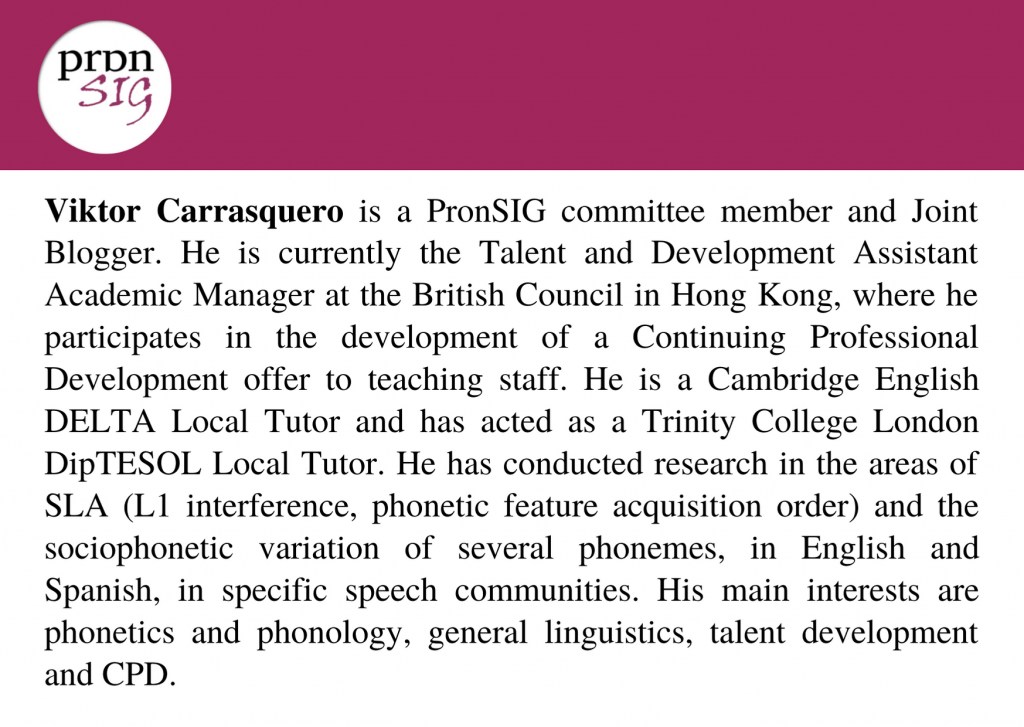Notes on Mark Hancock’s Making Pronunciation Activities Q&A session
by Viktor Carrasquero
For PronSIG’s first Ask the Expert! Q&A session, we were fortunate to have Mark Hancock, a widely recognised author and speaker in the field of pronunciation teaching. Mark has given us the EFL staples of Pronunciation Games, English Pronunciation in Use, the PronPack collection, and many more. In this post, I will revisit some of the key notions Mark addressed in the first half of the event, under his suggestion that pronunciation work can be divided into muscle, mind, memory, and meaning (MMMM); and I will also highlight his answers to some of the questions asked by the live audience, in the second half of the event.
MMMM
Mark got the conversation going by introducing his idea of pronunciation as a multifaceted phenomenon, one that comprises: a) muscle, a physical level in which organs of articulation work to produce sounds; b) mind, a cognitive level in which speakers and listeners recognise sound patterns, with intricate and fast encoding and decoding processes; c) meaning, an interactive element, as language users produce and listen for messages; and d) memory, the development of a “mental repertoire of how chunks of language sound” (Hancock, 2019). Mark used the pronunciation of the past tense, verb-final -ed variants to illustrate MMMM.
Muscle
In line with Underhill’s notion of proprioception (2012), Mark explained how learners of English need to develop new pronunciation habits, and that for this, they have to become increasingly aware of what happens physically, as they pronounce sounds and prosodic features -such as stress, intonation and rhythm. In the case of verb final -ed, Mark stressed the importance of explicitly guiding learners towards discovering and practising the extra syllable that is added in verbs ending in /t/ (as in want) and /d/ (as in need), not only by modelling such pronunciation, but also by giving learners opportunities to meaningfully practise the target sounds.
Mind
Mark told us how learners need to become aware of some specific knowledge about target pronunciation points. In the case of the past tense verb-final -ed, Mark reminded us that it is important for learners to become especially attuned to the insertion of an extra syllable, as outlined above. To reach such increased awareness, the learners’ cognitive and practical knowledge of syllables and syllabification has to be enhanced. Mark proposes poems and chants, where connected speech and linkings across word boundaries make syllabification straightforward.
Meaning
Interactive activities where learners have to communicate in ‘information gap’-type activities are examples of how we can focus on meaning, giving students opportunities to use the pronunciation of a specific feature to complete gaps, decode puzzles or just get the conversation going.
Memory
Mark talked about using different kinds of drilling, such as backchaining (see more on this here), and the importance of getting learners to listen to texts that “have a high density of a given pronunciation feature” (Hancock, 2019). This will, in turn, aid in the development and consolidation of pronunciation habits. Mark is also an advocate for the use of songs, raps, chants, and others, to give learners increased exposure to and more opportunities to practise a target feature.
Q&A
Mark answered elegantly, powerfully, and in very practical terms, many questions posed by the audience. These are but a few of the questions addressed. For more, you can watch the session in its entirety here.
- Does focusing on muscle positions really work for students? Even for young learners?
Mark reminded us that ‘muscle work’ doesn’t have to be overt, and that it’s not necessarily about giving phonetic gesture descriptions. He added that young learners are completely capable of feeling and reproducing phonetic gestures through raps, chants, etc.
- What can you say about choral repetition in large online classes?
Mark suggests asking all the class to switch their microphones off, and to drill the word / phrase / sentence that way. Teachers could then ask for volunteers to unmute themselves and drill the sequence for the whole class.
- What’s your creative process for designing materials?
Coincidentally, Mark keeps his MMMM in mind when coming up with ideas for materials. He also thinks about the nature of specific pronunciation problems: are they caused by spelling or by articulation?
- Are there significant differences between native speakers (NS) and non-native speakers (NNS) in teaching pronunciation?
Mark explained that the NS and NNS dichotomy is too simplistic and reductive, as we teachers, regardless of our first language, are to teach pronunciation and help learners with it. He added that sharing your learners’ L1 is actually a great advantage, as you may have a heightened awareness of the difficulties your learners encounter when tackling certain features. (Read more on this, in Mark’s own words, here).
- Why are some teachers scared of taking part in pronunciation courses?
To this, Mark said that “some teachers believe there’s one ‘correct’ pronunciation, and that joining a pronunciation course might be an attack on their self-worth”. He stressed the idea that “good pronunciation” is not sounding a specific way but your very own, intelligible way. Learning about pronunciation and about how to teach should not override your own accent, identity and who you are, but help you gain a deeper knowledge of the features whose control make communication easier.
At PronSIG, we are grateful that Mark took the time to talk to us, answering questions by our audience openly, candidly, and in a very practical, ‘take-it-into-class-tomorrow’ fashion. If you missed this Ask the Expert! session, click here to get all of Mark’s ideas, for inspiration, advice and motivation.
References
British Council. (n.d.). Backchaining. British Council Teaching English. <https://www.teachingenglish.org.uk/article/backchaining>
Hancock, M. (2021). I’m an English Teacher: should I worry about my accent? <https://www.cambridge.org/elt/blog/2021/02/24/english-teacher-should-worry-about-accent/>
Hancock, M. (2019). Pronunciation: muscle, mind, meaning, memory. English Teaching Professional. 122.
Underhill, A. (2012). Proprioception and Pronunciation. <https://www.adrianunderhill.com/2012/08/28/proprioception-and-pronunciation/>


